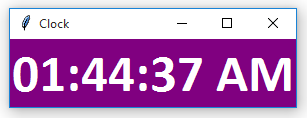Como sabemos, Tkinter se usa para crear una variedad de aplicaciones GUI (interfaz gráfica de usuario). En este artículo aprenderemos a crear un reloj digital usando Tkinter .
Requisitos previos:
-> Funciones de Python
-> Conceptos básicos de Tkinter (widget de etiqueta)
-> Módulo de tiempo
Usando el widget Label de Tkinter y el módulo de tiempo:
En la siguiente aplicación, vamos a usar el widget Label y también vamos a usar el módulo de tiempo que usaremos para recuperar el tiempo del sistema. A continuación se muestra la implementación:
Python3
# importing whole module
from tkinter import *
from tkinter.ttk import *
# importing strftime function to
# retrieve system's time
from time import strftime
# creating tkinter window
root = Tk()
root.title('Clock')
# This function is used to
# display time on the label
def time():
string = strftime('%H:%M:%S %p')
lbl.config(text = string)
lbl.after(1000, time)
# Styling the label widget so that clock
# will look more attractive
lbl = Label(root, font = ('calibri', 40, 'bold'),
background = 'purple',
foreground = 'white')
# Placing clock at the centre
# of the tkinter window
lbl.pack(anchor = 'center')
time()
mainloop()
Producción:

Publicación traducida automáticamente
Artículo escrito por sanjeev2552 y traducido por Barcelona Geeks. The original can be accessed here. Licence: CCBY-SA